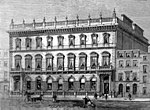Equestrian statue of William III, London
1808 sculpturesBronze sculptures in the United KingdomBuildings and structures completed in 1808Equestrian statues in the United KingdomGrade I listed monuments and memorials ... and 5 more
Grade I listed statues in the City of WestminsterMonuments and memorials in LondonOutdoor sculptures in LondonSculptures of men in the United KingdomStatues of William III of England

The equestrian statue of William III by John Bacon Junior stands in St James's Square in central London. It is modelled on an earlier statue of the king by John Michael Rysbrack in Queen Square, Bristol. Funding for the London statue was provided in the will of Samuel Travers, M.P., dated 1724, but nothing was done to progress the plan for a further seventy years. A design for the monument was drawn up in 1794 by Bacon's father, John Bacon Senior, but this was not executed and the commission passed to Bacon Jr., under whose direction the statue was finally erected in 1808. The statue is a Grade I listed structure.
Excerpt from the Wikipedia article Equestrian statue of William III, London (License: CC BY-SA 3.0, Authors, Images).Equestrian statue of William III, London
St James's Square, City of Westminster Victoria
Geographical coordinates (GPS) Address External links Nearby Places Show on map
Geographical coordinates (GPS)
| Latitude | Longitude |
|---|---|
| N 51.5072 ° | E -0.1353 ° |
Address
William III
St James's Square
SW1Y 4JH City of Westminster, Victoria
England, United Kingdom
Open on Google Maps







